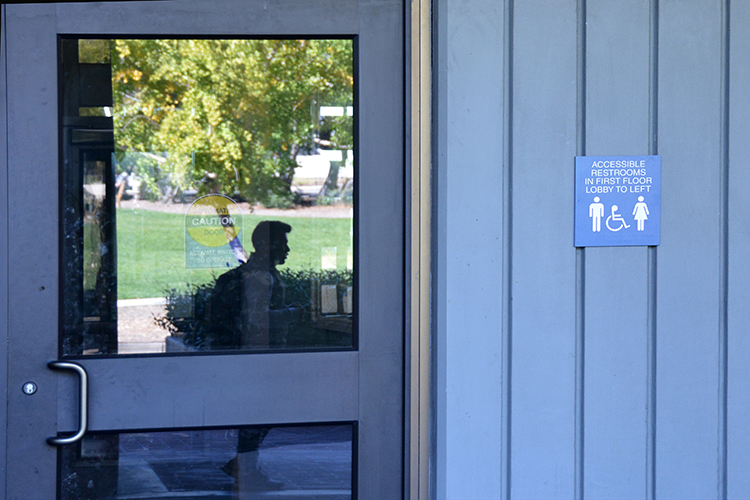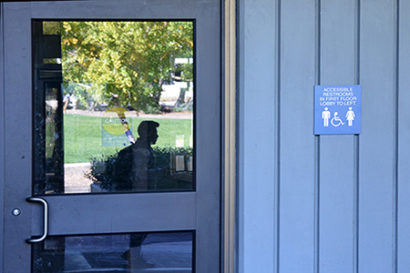Campus moves forward on gender-inclusive restrooms
More than 40 campus buildings now have updated facilities, and more are on the way

October 31, 2016
“Is it weird to be washing your hands next to me?” campus project manager Antonio Leony asked the young woman standing next to him at the sink. Shrugging her shoulders, she replied, “It is a little weird, but… it’s okay.”
They were some of the first users of a new gender-inclusive restroom on the first floor of Evans Hall on the UC Berkeley campus. The restroom was converted from multistall men’s and women’s rooms into one that is shared by all members of the community. It features eight fully enclosed stalls, one of them ADA accessible. The stall doors are designed to ensure privacy, and each stall has a fire alarm with a horn strobe and its own venting.

Signs like this one at Evans Hall indicates restrooms that are gender-neutral and ADA-compliant. (UC Berkeley photo by Hulda Nelson)
A shared sink in the middle of the room has new water-efficient fixtures. Energy-sparing LED lighting is controlled by a motion sensor, and new tiles and mirrors make the space much brighter than it was before.
Conversions like the one in Evans are signs of change on campus. While some campus buildings have offered inclusive facilities over the years, increasing advocacy and policy changes mean that gender-inclusive restrooms will be part of all new campus buildings as well as significant renovation projects.
To help people find the type of restroom they would prefer to use, Berkeley has put up a new information website and an online map of campus restrooms in order to make all existing gender-inclusive restrooms easier to find.
More than 40 campus buildings now have gender-inclusive restrooms, and more are on the way. Conversion of single-occupant restrooms from gender-specific to gender-inclusive has been actively underway for more than a year, spurred on by a systemwide policy change announced by the UC Office of the President in June 2015.
It’s important to make more inclusive spaces so everyone is welcome, says Billy Curtis, executive director of the Centers for Educational Justice and Community Engagement in the Division of Equity and Inclusion. Graduate student instructors had expressed concerns to Berkeley administrators that they had been told to leave restrooms or sometimes had to walk to another building to find facilities they could use.
“You can imagine that if you’re trying to do something as simple as using the restroom and you’re being constantly interrupted (by people saying you were using the wrong bathroom), that it would be at the very least annoying,” Curtis says, adding that it’s important for people using a restroom to feel safe.
The gender-inclusive restroom map, which will have a link on the campus’s main map page, also includes details about ADA-accessible gender-inclusive restrooms and the locations of restrooms with changing tables for babies. These developments are the result of a working group of students and staff who have been collecting and coordinating information about efforts across campus for more than a year. A regularly updated list of conversion milestones is available.
While progress is being made, the updates take time, and restroom renovations can take a lot of time and money, says Christine Shaff of the campus’s real estate division. Further complicating the efforts is that while state and federal codes have to be followed, many of them have not yet caught up to changing social standards. This means renovations of existing structures can’t violate existing codes to create gender-inclusive facilities.
“The campus is committed to providing comfortable and accessible restrooms for everyone’s use,” says Emily Marthinsen, an assistant vice chancellor and campus architect. Marthinsen, who was part of the group who worked with the graduate students petitioning for gender-neutral restrooms.
“We see this as an opportunity to make sure that restrooms are available to everyone as a matter of course,” Marthinsen says.